MPPT vs PWM in cold weather
This post is inspired by a comment from Jeremy.
I plotted MPPT+mono panels, MPPT+poly panels, PWM+mono, and PWM+poly against ambient temperature to see how the combinations fare.
The guinea pigs were the Renogy 100w mono (Vmp 18.9v, Imp 5.29A) and 100w poly (Vmp 17.8v, Imp 5.62A) panels.
We assume full overhead sun, Vabs 14.8v, and 50% Depth of Discharge 12.1v. Note that the graph starts at 50w so we can see some detail.
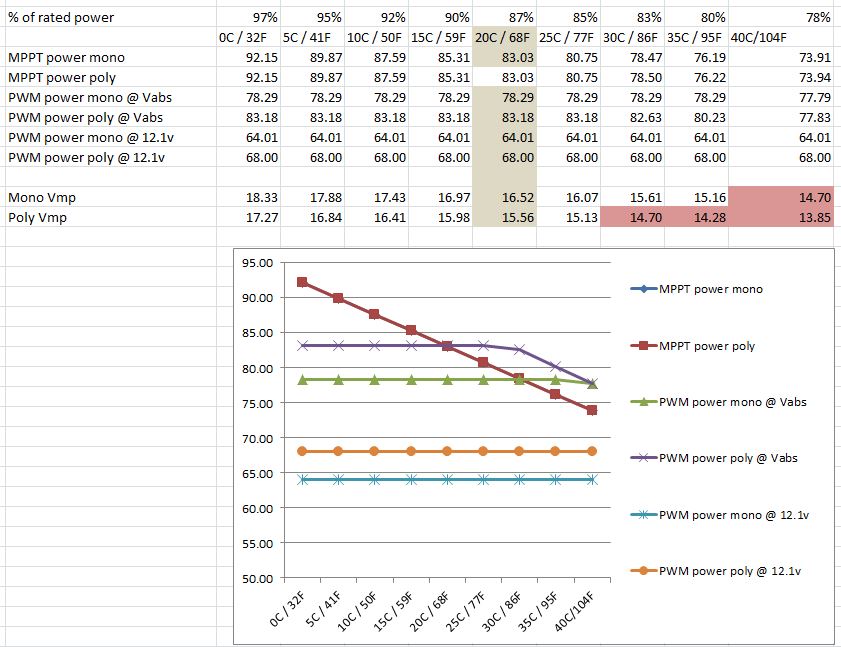
#
Observations
##
MPPT nearly identical performance with mono and poly
This isn’t the point of the post but it’s a graphing weirdness I should point out. MPPT power output on the two panel types are so close that the red MPPT power poly line overlays and obscures the blue MPPT power mono line. You can see tiny bits of the mono diamond sticking out from the poly squares:
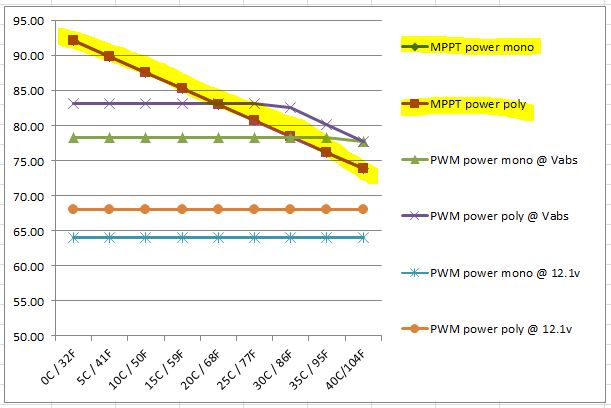
##
Hot ambient temps and panel voltage
By about 80F the poly panels can no longer output the necessary 14.8v for Absorption. By about 100F the higher voltage mono panels drop below 14.8v too.
Note that higher voltage panels (20v or 24v nominal) will not have this issue with 12v nominal battery banks.
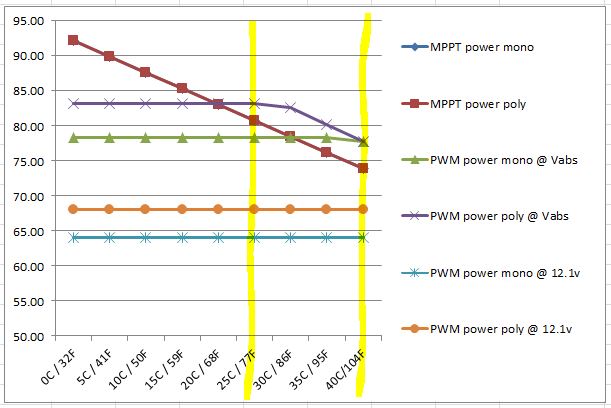
best and worst case scenarios for PWM
Since PWM runs the solar panels at battery voltage (Vbatt), PWM performs best at Vabs and worst at 50% DoD. Compare the relatively high output at Vabs and the tragically low when the bank is discharged (when you need it most).
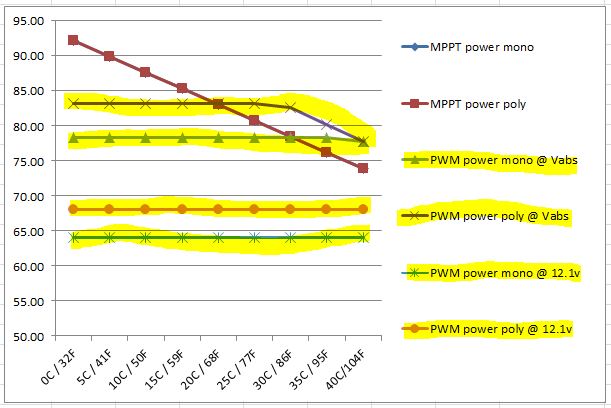
mono vs poly panels for PWM controllers
Using the same image just above, note that poly outperforms mono on PWM controllers. It may be counterintuitive since mono has won the buzzword competition amongst instagram yoga practitioners.
Here’s why this is so:
-
mono panels have a higher Vmp than poly. 18.9v vs. 17.8v in our example.
-
PWM runs the panels at Vbatt so it will never run them higher than 14.8v in our example. The higher Vmp doesn’t directly matter since PWM can’t run the panels at Vmp anyhow.
-
Since Watts = Volts * Amps, a 100w mono with higher Vmp must have lower current rating than poly with lower Vmp. Mono 5.29A vs poly 5.62A in our example.
-
When operating the panel at any particular Vbatt (as PWM does), the lower voltage panel will make more power. Mono 14.8v * 5.29A = 78.3w. Poly 14.8v * 83.3w.
Note that while poly panels drop below 14.8v earlier, they are still generating more power (watts) due to higher current than mono. This power disparity goes away at about 105F. Hopefully you won’t be camping in 105F temps.
MPPT can make less power than PWM
Another counterintuitive wrinkle. While MPPT usually makes more power than PWM, the DC-DC conversion trickery involved sacrifices a bit of efficiency. For our example we used a 95% efficiency rating for our MPPT controller – that’s a typical number.
When high ambient temperatures cause Vmp to fall, the MPPT can end up producing less power than PWM.
-
with mono panels this happens around 90F
-
with poly panels this happens around 70F!
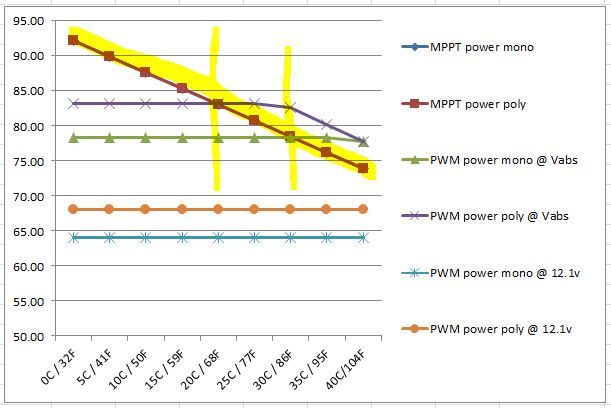
Takeaways
-
MPPT makes more power than PWM in cold temperatures
-
MPPT makes more power than PWM when battery voltage is low, like in the morning after boondocking
-
MPPT advantage is greatest when battery voltage is low and ambient temps are near cold. This is the source of the “33% more power!” stat often seen in marketing materials. See table below.
-
MPPT advantage reduces as ambient temperatures and battery voltages increase
-
Given high enough ambient temperatures, PWM can make more power than MPPT due to the latter’s DC-DC conversion losses. With Renogy 100w panels this happens at ~100F for mono and ~70F for poly.
-
If you are using MPPT controllers, either poly or mono panels will do.
-
If you are using PWM controllers, poly panels will generally make more power
| MPPT advantage | mono 50% | mono 13.4v | mono 14.8v | poly 50% | poly 13.4v | poly 14.8v | ||
| OC | 44% | 30% | 18% | 36% | 22% | 11% | ||
| 20C | 30% | 17% | 6% | 22% | 10% | 0% | ||
| 40C | 15% | 4% | -5% | 9% | -2% | -5% | ||
While MPPT does provide benefits in most circumstances it comes at about 3x the price. Only you know if it’s worth it or not.